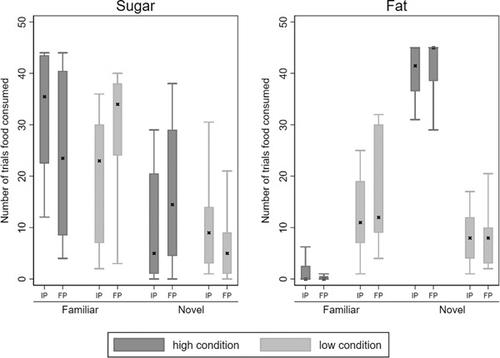当前位置:
X-MOL 学术
›
Am. J. Primatol.
›
论文详情
Our official English website, www.x-mol.net, welcomes your feedback! (Note: you will need to create a separate account there.)
The role of novelty and fat and sugar concentration in food selection by captive tufted capuchins (Sapajus apella).
American Journal of Primatology ( IF 2.4 ) Pub Date : 2020-07-02 , DOI: 10.1002/ajp.23165 Benjamin Heuberger 1 , Annika Paukner 2, 3 , Lauren J Wooddell 3, 4 , Matt Kasman 1 , Ross A Hammond 1, 5, 6
American Journal of Primatology ( IF 2.4 ) Pub Date : 2020-07-02 , DOI: 10.1002/ajp.23165 Benjamin Heuberger 1 , Annika Paukner 2, 3 , Lauren J Wooddell 3, 4 , Matt Kasman 1 , Ross A Hammond 1, 5, 6
Affiliation

|
Capuchins, like other primates, use feedback from sensory cues and digestion to make decisions about which foods to consume and which to avoid. However, little is known about how capuchins make consumption decisions when simultaneously presented with novel and familiar foods, or how food familiarity and macronutrient concentration together influence food choice, topics with potential implications for developmental and health research. In this study, we evaluated the role of familiarity, as well as fat and sugar concentration, in the food selections of captive tufted capuchins (Sapajus apella ). In the first experiment, over 10 sessions, subjects were assigned to either a group that chose between one familiar and one novel food item both high in fat or sugar (high condition), or to a group that chose between one familiar and one novel food item both low in fat or sugar (low condition). In the second experiment, subjects were divided into three groups, familiarized with food over five feeding sessions, and then offered the familiarized food and a novel food that varied in fat or sugar for 10 sessions. When offered foods high in fat, capuchins showed no clear signs of neophobia, forming an initial preference for the novel food, rejecting foods less frequently, and selecting foods faster than when offered foods low in fat. These trends were generally not observed in response to foods with sugar. When presented with options that varied in macronutrient concentration, subjects showed an initial interest in the novel food irrespective of whether it was high in fat or sugar, yet formed a final preference for the higher‐concentration item. Findings suggest that the concentration of fat or sugar in novel foods may be an important mediator of exploratory behavior and that capuchins rely on immediate feedback from taste and other sensory cues to make consumption decisions.
中文翻译:

圈养簇绒卷尾猴(Sapajus apella)在食物选择中的新奇性和脂肪和糖浓度的作用。
像其他灵长类动物一样,卷尾猴使用来自感官提示和消化的反馈来决定食用哪些食物和避免哪些食物。然而,关于卷尾猴如何在与新奇和熟悉的食物同时出现时做出消费决定,或者食物熟悉度和常量营养素浓度如何共同影响食物选择,这些对发育和健康研究具有潜在影响的主题知之甚少。在这项研究中,我们评估了熟悉度以及脂肪和糖浓度在圈养簇绒卷尾猴 ( Sapajus apella ) 食物选择中的作用。)。在第一个实验中,超过 10 节课,受试者被分配到一组在一种熟悉的食物和一种新奇的高脂肪或高糖食物之间进行选择(高条件),或者分配到一组在一种熟悉的食物和一种新奇食物之间进行选择低脂肪或低糖(低状态)的项目。在第二个实验中,受试者被分成三组,在 5 次喂食期间熟悉食物,然后在 10 次喂食期间提供熟悉的食物和一种脂肪或糖分不同的新食物。当提供高脂肪食物时,卷尾猴没有表现出明显的新恐惧症迹象,形成了对新食物的最初偏好,拒绝食物的频率较低,并且比提供低脂肪食物时更快地选择食物。对含糖食物的反应通常没有观察到这些趋势。当提供不同常量营养素浓度的选项时,受试者最初对新食物表现出兴趣,无论它是高脂肪还是高糖,但最终形成了对高浓度食物的偏好。研究结果表明,新食物中脂肪或糖的浓度可能是探索行为的重要中介,而卷尾猴依靠味觉和其他感官线索的即时反馈来做出消费决定。
更新日期:2020-07-24
中文翻译:

圈养簇绒卷尾猴(Sapajus apella)在食物选择中的新奇性和脂肪和糖浓度的作用。
像其他灵长类动物一样,卷尾猴使用来自感官提示和消化的反馈来决定食用哪些食物和避免哪些食物。然而,关于卷尾猴如何在与新奇和熟悉的食物同时出现时做出消费决定,或者食物熟悉度和常量营养素浓度如何共同影响食物选择,这些对发育和健康研究具有潜在影响的主题知之甚少。在这项研究中,我们评估了熟悉度以及脂肪和糖浓度在圈养簇绒卷尾猴 ( Sapajus apella ) 食物选择中的作用。)。在第一个实验中,超过 10 节课,受试者被分配到一组在一种熟悉的食物和一种新奇的高脂肪或高糖食物之间进行选择(高条件),或者分配到一组在一种熟悉的食物和一种新奇食物之间进行选择低脂肪或低糖(低状态)的项目。在第二个实验中,受试者被分成三组,在 5 次喂食期间熟悉食物,然后在 10 次喂食期间提供熟悉的食物和一种脂肪或糖分不同的新食物。当提供高脂肪食物时,卷尾猴没有表现出明显的新恐惧症迹象,形成了对新食物的最初偏好,拒绝食物的频率较低,并且比提供低脂肪食物时更快地选择食物。对含糖食物的反应通常没有观察到这些趋势。当提供不同常量营养素浓度的选项时,受试者最初对新食物表现出兴趣,无论它是高脂肪还是高糖,但最终形成了对高浓度食物的偏好。研究结果表明,新食物中脂肪或糖的浓度可能是探索行为的重要中介,而卷尾猴依靠味觉和其他感官线索的即时反馈来做出消费决定。


























 京公网安备 11010802027423号
京公网安备 11010802027423号